Well, as you know I have bought a Sigma 24-70mm + Macro. Since I rarely shoot with my 50mm f/1.8 I have decided to let it go too. For macro photography, I think I will pleasantly be surprised with the macro capability of the Sigma lens in front of an extension tube. The Tokina 80-400mm can do wonderful macro already with the extension tube so I expect the Sigma to perform very well in macro mode.
The 50mm is on its way out. I do not miss the f/1.8 as I do not find myself using it often enough. I might pick it up again at a later time.
The wasp ... my subject. I closed my windows for a few days as the wasp refused to get out. Well, the wasp is gone ... disappeared. It is not laying dead in my window frame. It disappeared. My macro subject is gone.
Friday, October 31, 2008
Camera hand grip
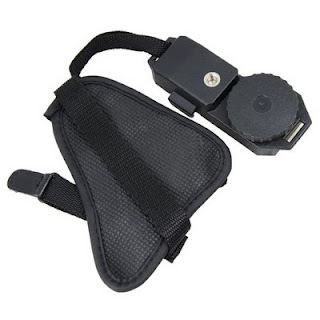
I just bought this camera hand grip from eBay. I am impatiently waiting for it to arrive before I have to fly out of here to Costa Rica. I think this is a neat invention as I often find my hand getting fairly stiff after holding the camera up for 30 minutes or longer. I have done this at weddings. It was tough.
Hopefully this will work!
Wednesday, October 22, 2008
Vivitar 70-210mm f3.5
Well, I will miss this lens. I just let it go today with the 2x teleconverter. A beautiful lens. An art of optics.
Meanwhile, I decided to purchased the Sigma 24-70mm f2.8 anyway as I am going to Costa Rica soon. That and my 18-200mm will be fighting for the walk-around lens title. I am worried about humidity.
Meanwhile, I decided to purchased the Sigma 24-70mm f2.8 anyway as I am going to Costa Rica soon. That and my 18-200mm will be fighting for the walk-around lens title. I am worried about humidity.
Monday, October 20, 2008
Constant aperture zoom lens
Recently, I ran into a sale of a Sigma 24-70mm f2.8 lens. I was very tempted to buy it but upon reviewing other people's experience with the lens, I was left a little confused. Many people claim that at the widest aperture, images are a little soft -- which is true of virtually every lens out there. They claim that you really need to shoot at f4 to f16 to get tack sharp pictures.
So, what does that mean then? I want to buy a fast lens but I have to stop it down if I want sharp pictures. How is that better than my Nikkor 18-200mm f3.5-5.6 VRII? With VRII, I can gain 2 f-stops. So, I guess before I buy it, I need to get my hand on a test lens or someone can do a comparison between these lenses.
So, what does that mean then? I want to buy a fast lens but I have to stop it down if I want sharp pictures. How is that better than my Nikkor 18-200mm f3.5-5.6 VRII? With VRII, I can gain 2 f-stops. So, I guess before I buy it, I need to get my hand on a test lens or someone can do a comparison between these lenses.
Sunday, October 12, 2008
Macro photography
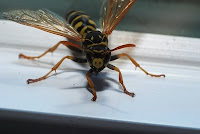 Well, I was not planning to do any shooting today although the idea of another hiking trip was very appealing in this 25C temperature, but a buzzing noise was hovering over to my right in my bedroom. The last time I heard that buzzing was from a wasp that managed its way into my room a few weeks ago. I wondered where it came from. Well, today, I see two of them. I think there is a hole in my new window frame and their nest is somewhere close, very close.
Well, I was not planning to do any shooting today although the idea of another hiking trip was very appealing in this 25C temperature, but a buzzing noise was hovering over to my right in my bedroom. The last time I heard that buzzing was from a wasp that managed its way into my room a few weeks ago. I wondered where it came from. Well, today, I see two of them. I think there is a hole in my new window frame and their nest is somewhere close, very close.Anyways, I decided to test the macro capability of my Vivitar
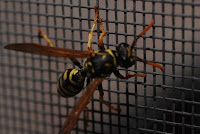 70-210mm. Alone, it can produce 1:2.2 real life ratio. Added the 2x teleconverter I have, I can whip up a near real life macro shot, at 1:1.1. I took a few shots of the wasp but I had set the shutter speed too slow at 1/10 secs so the pictures turned out a little blurry. I did however get a couple of shots at 1/320 secs. I also tested my 50mm lens with one 50mm extension tube to take a few shots of the wasp.
70-210mm. Alone, it can produce 1:2.2 real life ratio. Added the 2x teleconverter I have, I can whip up a near real life macro shot, at 1:1.1. I took a few shots of the wasp but I had set the shutter speed too slow at 1/10 secs so the pictures turned out a little blurry. I did however get a couple of shots at 1/320 secs. I also tested my 50mm lens with one 50mm extension tube to take a few shots of the wasp.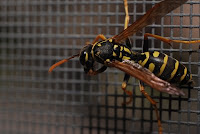 The first four shots are from the Nikkor 50mm. The last two on the right are from the Vivitar 70-210mm. The original photos have been resized to 1024x685 but they are not cropped so what we see here is what filled the sensor screen. With either lens, you have to get to about 10 cm of the subject. It was a little unnerving to get so close to a wasp (as I had been stung once) but this one was very gentle.
The first four shots are from the Nikkor 50mm. The last two on the right are from the Vivitar 70-210mm. The original photos have been resized to 1024x685 but they are not cropped so what we see here is what filled the sensor screen. With either lens, you have to get to about 10 cm of the subject. It was a little unnerving to get so close to a wasp (as I had been stung once) but this one was very gentle.For these shots, I had to use the external speedlight set on Manual
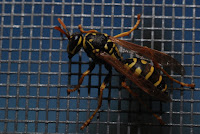 mode as the built-in flash is too low -- the Vivitar lens is almost a foot long. In Manual mode, the speedlight does not talk with the camera so it was a little painful trying to figure out the right setting without a light meter. I wish I had a D300 or one of the other professional DSLRs that can meter with the manual lenses. I had to take a few shots and adjusting power output level of the fash, before getting the right exposure.
mode as the built-in flash is too low -- the Vivitar lens is almost a foot long. In Manual mode, the speedlight does not talk with the camera so it was a little painful trying to figure out the right setting without a light meter. I wish I had a D300 or one of the other professional DSLRs that can meter with the manual lenses. I had to take a few shots and adjusting power output level of the fash, before getting the right exposure.The lens aperture was set between f/8 and f/22. The speedlight
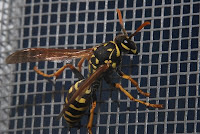 was set somewhere between 1/128 to 1/1 depending on the shutter speed I used.
was set somewhere between 1/128 to 1/1 depending on the shutter speed I used.For most of the shots at f/16 or f/22, the power output from the flash was set to 1/1. I just cannot remember which photos were shot at minimum aperture but the last two photos were shot at f/16.
So, which lens do I prefer for macro photography? I have to say, the old 1975 Vivitar lens was easier to use. At whatever aperture I dialed, you could still view the subject clearly in the viewfinder -- the Vivitar lens is a bigger, wider lens than the 50mm so
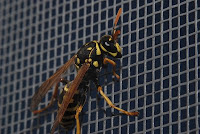 at f/22 the Vivitar aperture is the same size as the Nikkor 50mm lens at f/8. That is, the Vivitar can gather a vast amount of light even at f/22. With the Nikkor 50mm, without background light, it may be impossible to see what you are shooting. So, for this reason, I prefer the Vivitar and while I had the intention to sell it because I hardly ever used it, I will keep it for macro photography now.
at f/22 the Vivitar aperture is the same size as the Nikkor 50mm lens at f/8. That is, the Vivitar can gather a vast amount of light even at f/22. With the Nikkor 50mm, without background light, it may be impossible to see what you are shooting. So, for this reason, I prefer the Vivitar and while I had the intention to sell it because I hardly ever used it, I will keep it for macro photography now.
Monday, October 6, 2008
Fighting the temptation
I think photography is evil. I saw this Sigma 18-50mm f2.8 EX DC lens that someone in the area wanted to sell for $325. My first thought was, wow! I gotta get this lens. I have read some good reviews about this lens and a couple bad ones. This lens was praised for being fast and sharp. I was so tempted to buy it as I am planning a trip to Costa Rica. Such a lens would be very nice for the thick canopy of the rainforest. However, it took me a few hours to realize that unless I use a D700 or D3 with an f1.8 lens, there is not much I can do about the light conditions under the canopy. I will have to resort to a hotshoe flash to capture things within 13 metres from me. Besides, I already own a Nikkor 50mm f1.8 prime lens, over a full stop faster than the Sigma lens. My Nikkor 18-200mm f3.5-5.6 is only half a stop slower than the f2.8 and with VR, it should outperform the Sigma from 18-50mm, so I should after all be content with my set of glasses. I have to keep my excitement under control or I will end up spending thousands of dollars on gears that are simply redundant.
Subscribe to:
Comments (Atom)
Potensic Atom Follow-Me Mode
The Potensic Atom's Follow-Me mode is one of its "intelligent flight" modes. It's a really nifty feature that uses visual...

-
Here's a tip for flying the Potensic Atom's Return Home feature. First, take off from an open space with no obstruction such that ...
-
A local Zellers store is having liquidation sales of everything in the store. I was browsing through some electronics the other day--not pl...
-
The Potensic Atom's Follow-Me mode is one of its "intelligent flight" modes. It's a really nifty feature that uses visual...